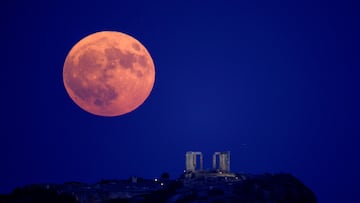Monday’s super blue full moon live updates: Watch the August sturgeon moon online
Tonight’s seasonal blue moon is also a supermoon, meaning sky-gazers could be in for a treat with the moon looking bigger and brighter than usual.


Show key events only
Super Blue Full Moon live
Here's Gidget explaining where best to see the Super Blue Moon tonight.
Why is it called a Blue Moon?
How the Blue Moon got its name is somewhat shrouded in mystery. The original use may have come from a satirical work Rede Me and Be Nott Wrothe, with the line: “If they say the moon is blue, We must believe that it is true”, with the idea that the moon being blue was an absurd one.
In the original the text read in Middle English: “Yf they saye the mone is belewe / We must believe that it is true” which led to what was apparently a false etymology, confusing 'belewe', blue, with 'belǽwan', Old English for to betray, with the idea it was a betrayer moon, because it upset the calendar calculations for the church.
Blue moon enters the English language
An actually blue-colored moon may have been referenced by poet Percy Byshee Shelley in his poem ‘Alastor’, written in 1816 at the time of the eruption of Mount Tambora, which caused global atmospheric effects. Soon after the idea of 'Blue Moon' as a metaphor for something that occurs rarely appeared. 'Once in a Blue Moon' dates back to 1833.
Applying Blue Moon to actual Full Moons
The application of Blue Moon to apply to specific calendar appearances of the Full Moon comes from the Maine Farmers' Almanac, which stated:
The Moon usually comes full twelve times in a year, three times in each season... However, occasionally the moon comes full thirteen times in a year. This was considered a very unfortunate circumstance, especially by the monks who had charge of the calendar. It became necessary for them to make a calendar of thirteen months, and it upset the regular arrangement of church festivals. For this reason thirteen came to be considered an unlucky number. Also, this extra moon had a way of coming in each of the seasons so that it could not be given a name appropriate to the time of year like the other moons. It was usually called the Blue Moon... In olden times the almanac makers had much difficulty calculating the occurrence of the Blue Moon and this uncertainty gave rise to the expression "Once in a Blue Moon.
Most experts consider that the article itself was hoax, a joke or simply misinformed. However the seasonal definition stuck. The calendar definition - two full moons in a calendar month - was the result of a mistake by James Hugh Pruett in a 1946 article in Sky and Telescope, however it is now considered to be a correct usage of the term, and in fact is somewhat more commonly known.
When is the next Blue Moon?
The next seasonal Blue Moon is in 2027, on May 20. The next calendar Blue Moon is on May 31, 2026.
A seasonal Blue Moon is the third of four Full Moons in an astronomical season. A calendar Blue Moon is the second of two Full Moons in a calendar month.
Tonight's full moon is a blue moon, that's also a super moon and it's also called the sturgeon moon. Our Greg explains why.
Super Blue Full Moon
While we wait for the moon in the U.S., check out the moon over Frankfurt airport. Moonrise is about 2 hours 40 minutes into the feed, so scroll back for the amazing appearance of our natural satellite.
Why is tonight’s Full Moon a Blue Moon?
Tonight’s full moon is a Blue Moon, taking place at 2:26 p.m. ET. The tricky thing is that there are two types of Blue Moons, monthly and seasonal. A monthly Blue Moon is when there are two Blue Moons in one calendar month (note that as there are about 29.5 days between full moons, February, with 28 or 29 days can never have a monthly Blue Moon).
A seasonal Blue Moon is rather different, it is the THIRD Full Moon of an astronomical season that has FOUR Full Moons. An astronomical season runs from solstice to equinox and equinox to solstice. So summer 2024 runs from the June solstice (June 20) to the September equinox (September 22) and in that time we have four Full Moons: June 22, July 21, August 19 (Blue Moon) and September 18.
The third of the four Full Moons is the one tonight, the Blue Moon.
What is a Supermoon Blue Moon?
The August Full Moon is a Supermoon because the moon is at the point in its orbit where it’s closest to the Earth, meaning it appears bigger and brighter. According to NASA this Supermoon is about 6.2% bigger and 12.8% brighter than an average Full Moon.
Hello and welcome to our live coverage of the Super Blue Full Moon, which reaches its peak at 2:26 p.m. ET, but will be visible once it gets dark across the U.S. this evening.


Complete your personal details to comment